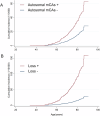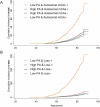Association of autosomal mosaic chromosomal alterations with risk of bladder cancer in Chinese adults: a prospective cohort study
- PMID: 39349436
- PMCID: PMC11443067
- DOI: 10.1038/s41419-024-07087-6
Association of autosomal mosaic chromosomal alterations with risk of bladder cancer in Chinese adults: a prospective cohort study
Abstract
Little is known about the prospective association between autosomal mosaic chromosomal alterations (mCAs), a group of large-scale somatic mutations on autosomes, and bladder cancer. Here we utilized data from 99,877 participants who were free of physician-diagnosed cancer at baseline (2004-2008) of the China Kadoorie Biobank to estimate the associations between autosomal mCAs and bladder cancer (ICD-10: C67). A total of 2874 autosomal mCAs events among 2612 carriers (2.6%) were detected. After a median follow-up of 12.4 years, we discovered that participants with all autosomal mCAs exhibited higher risks of bladder cancer, with a multivariable-adjusted hazard ratio (HR) (95% confidence interval [CI]) of 2.60 (1.44, 4.70). The estimate of such association was even stronger for mosaic loss events (HR [95% CI]: 6.68 [2.92, 15.30]), while it was not significant for CN-LOH events. Both expanded (cell fraction ≥10%) and non-expanded autosomal mCAs, as well as mosaic loss, were associated with increased risks of bladder cancer. Of interest, physical activity (PA) significantly modified the associations of autosomal mCAs and mosaic loss (Pinteraction = 0.038 and 0.012, respectively) with bladder cancer. The increased risks of bladder cancer were only observed with mCAs and mosaic loss among participants with a lower level of PA (HR [95% CI]: 5.11 [2.36, 11.09] and 16.30 [6.06, 43.81]), but not among participants with a higher level of PA. Our findings suggest that peripheral leukocyte autosomal mCAs may represent a novel risk factor for bladder cancer, and PA may serve as a potential intervention target for mCAs carriers.
© 2024. The Author(s).
Conflict of interest statement
The authors declare no competing interests.
Figures



Similar articles
-
Association of the interaction between mosaic chromosomal alterations and polygenic risk score with the risk of lung cancer: an array-based case-control association and prospective cohort study.Lancet Oncol. 2022 Nov;23(11):1465-1474. doi: 10.1016/S1470-2045(22)00600-3. Epub 2022 Oct 18. Lancet Oncol. 2022. PMID: 36265503
-
Hematopoietic mosaic chromosomal alterations increase the risk for diverse types of infection.Nat Med. 2021 Jun;27(6):1012-1024. doi: 10.1038/s41591-021-01371-0. Epub 2021 Jun 7. Nat Med. 2021. PMID: 34099924 Free PMC article.
-
Mosaic Chromosomal Alterations Are Associated With Increased Lung Cancer Risk: Insight From the INTEGRAL-ILCCO Cohort Analysis.J Thorac Oncol. 2023 Aug;18(8):1003-1016. doi: 10.1016/j.jtho.2023.05.001. Epub 2023 May 5. J Thorac Oncol. 2023. PMID: 37150255 Free PMC article.
-
Risk factors for clonal hematopoiesis of indeterminate potential and mosaic chromosomal alterations.Transl Res. 2023 May;255:171-180. doi: 10.1016/j.trsl.2022.11.009. Epub 2022 Nov 20. Transl Res. 2023. PMID: 36414227 Free PMC article. Review.
-
Genetics of autosomal mosaic chromosomal alteration (mCA).J Hum Genet. 2021 Sep;66(9):879-885. doi: 10.1038/s10038-021-00964-4. Epub 2021 Jul 28. J Hum Genet. 2021. PMID: 34321609 Review.
Cited by
-
A complex systems approach to mosaic loss of the Y chromosome.Geroscience. 2025 Feb;47(1):631-651. doi: 10.1007/s11357-024-01468-7. Epub 2024 Dec 16. Geroscience. 2025. PMID: 39680277 Free PMC article. Review.
References
-
- Ferlay J, Ervik M, Lam F, Laversanne M, Colombet M, Mery L, et al. Global Cancer Observatory: Cancer Today. Lyon, France: International Agency for Research on Cancer; 2022. Available from: https://gco.iarc.fr/today
-
- Botteman MF, Pashos CL, Redaelli A, Laskin B, Hauser R. The health economics of bladder cancer. Pharmacoeconomic. 2003;21:1315–30. - PubMed
-
- Mossanen M, Gore JL. The burden of bladder cancer care: direct and indirect costs. Curr Opin Urol. 2014;24:487. - PubMed
-
- Berdik C. Unlocking bladder cancer. Nature. 2017;551:S34–5. - PubMed
MeSH terms
Grants and funding
- WT_/Wellcome Trust/United Kingdom
- 82192901,82192904, 82192900,81390540, 91846303, 81941018/National Natural Science Foundation of China (National Science Foundation of China)
- 2011BAI09B01/Chinese Ministry of Science and Technology | Department of S and T for Social Development (Department of S&T for Social Development)
- 212946/Z/18/Z, 202922/Z/16/Z, 104085/Z/14/Z, 088158/Z/09/Z/Wellcome Trust (Wellcome)
LinkOut - more resources
Full Text Sources
Medical

